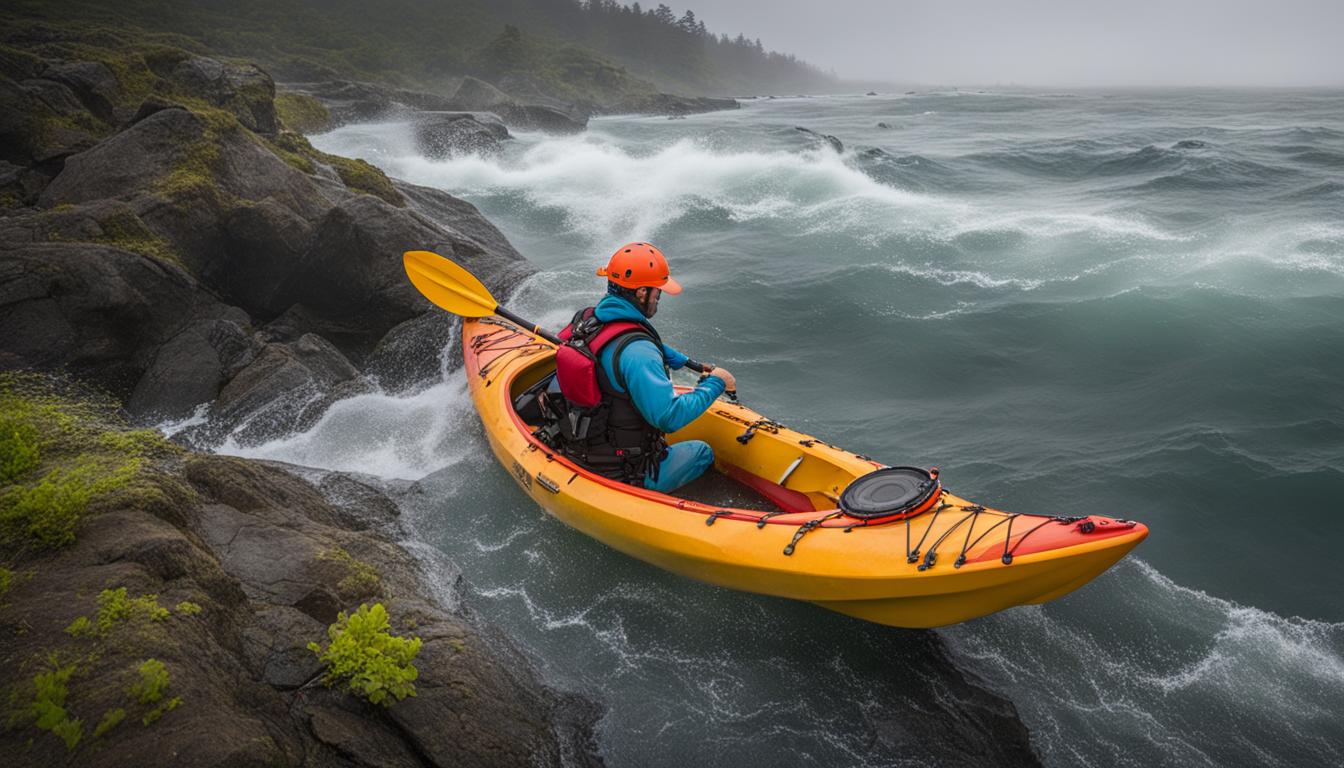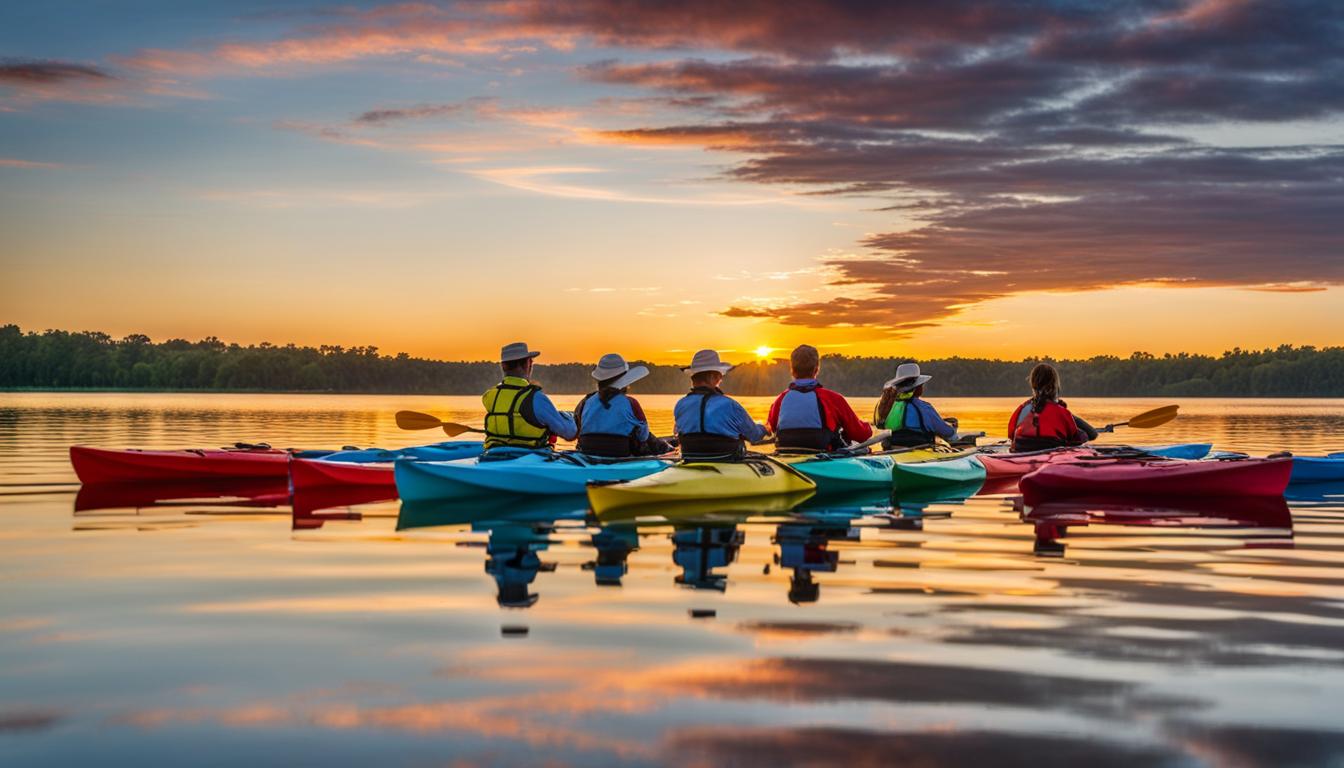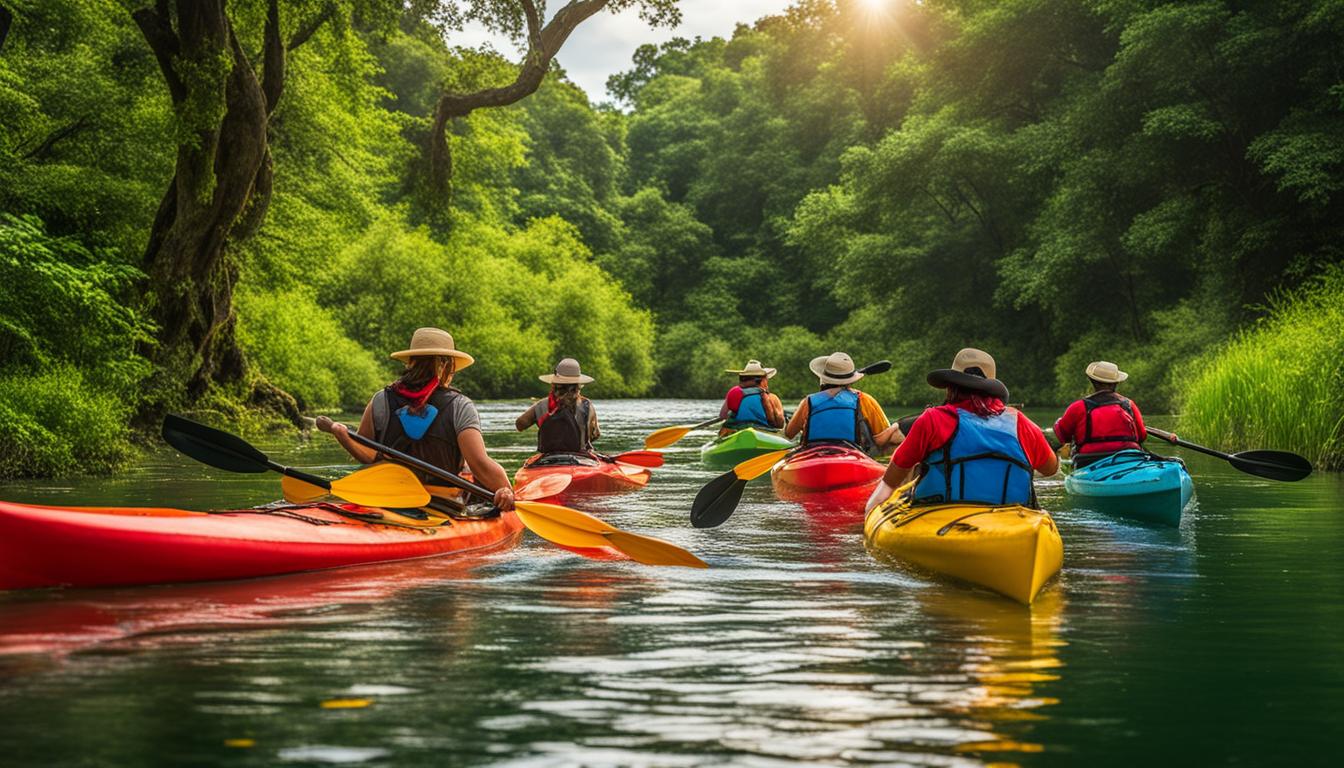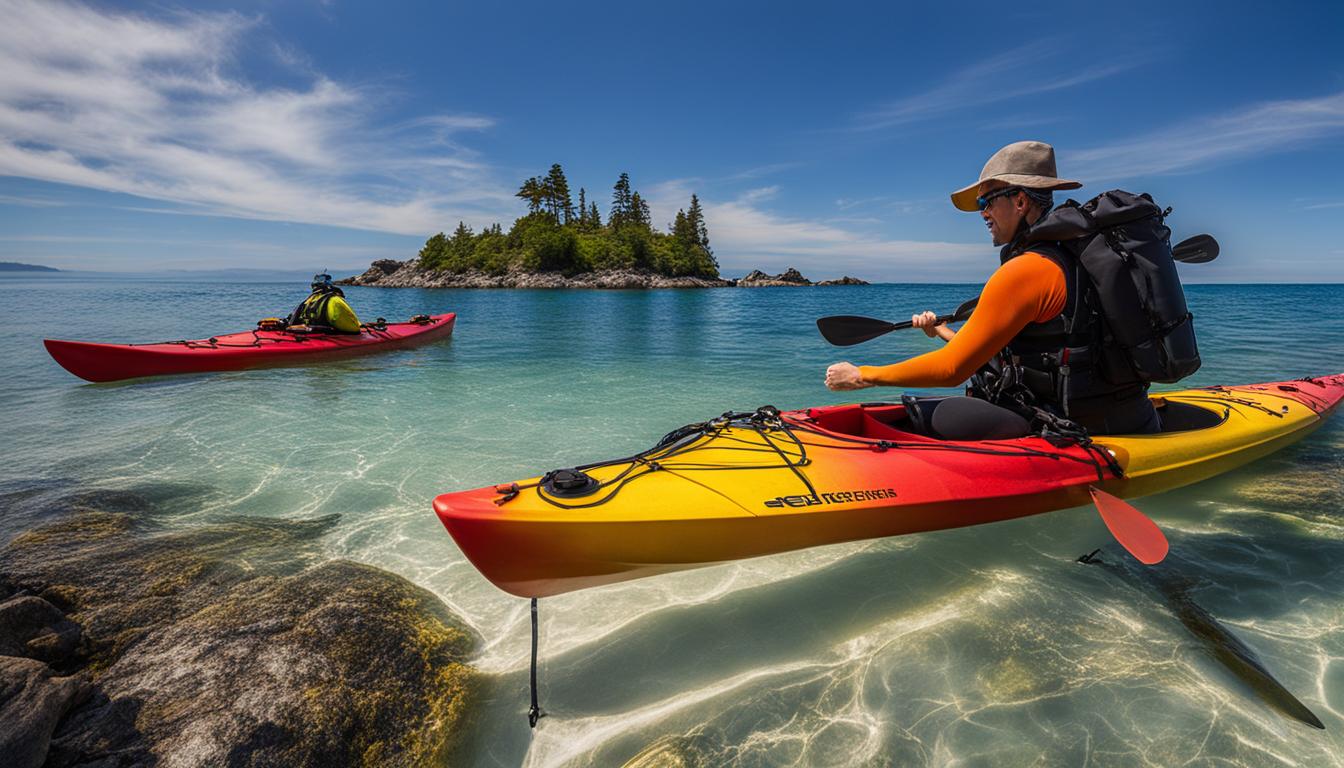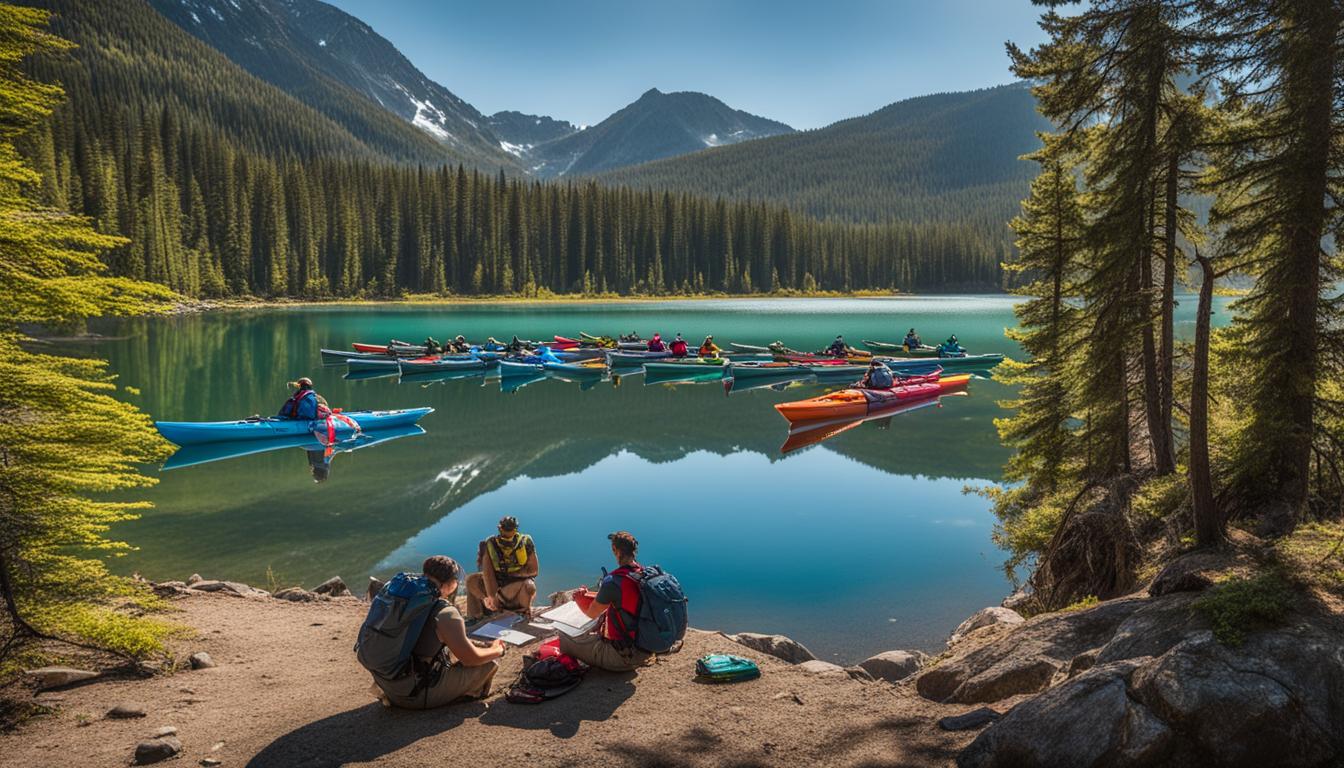Kayak camping trips provide a unique and adventurous experience, but it’s important to be prepared for any emergencies that may arise. By packing the right gear and following safety guidelines, you can ensure a safe and enjoyable kayak camping adventure. Here are some essential tips for emergency preparedness on your kayak camping trip.
Key Takeaways:
- Pack essential gear such as a personal flotation device, spare paddle, paddle float, bilge pump, and repair kit.
- Learn kayak rescue techniques and carry emergency signaling devices.
- Carry a first aid kit, establish a communication plan, and have a contingency plan in place.
- Choose appropriate clothing and footwear for kayak camping.
- Pack non-perishable food, enough water, and have a shelter plan.
Essential Gear for Kayak Emergency Preparedness
When it comes to kayak emergency preparedness, having the right gear is crucial. By packing the necessary equipment, you can be better prepared for any unexpected situations that may arise during your kayak camping trip. Here are some essential items to consider:
River Expedition Kit
| Item | Quantity |
|---|---|
| Personal Flotation Device (PFD) | 1 per person |
| Spare Paddle | 1 |
| Paddle Float | 1 |
| Bilge Pump or Sponge | 1 |
| Running Light or Deck Light | 1 |
| Repair Kit | 1 |
| Emergency Signaling Devices | Flares, whistle |
Having a personal flotation device (PFD) is essential to ensure buoyancy and safety in case of an emergency. Packing a spare paddle is also recommended in case your main paddle gets lost or damaged. A paddle float can be used to aid in self-rescue or assisting others. A bilge pump or sponge can help remove water from your kayak if it starts to take on water. Additionally, a running light or deck light can increase your visibility during low-light conditions. Be sure to carry a repair kit for any hull or equipment damage and consider bringing emergency signaling devices like flares or a whistle to attract attention if needed.
It’s important to familiarize yourself with kayak rescue techniques and practice them before your trip. Knowing how to perform self-rescue maneuvers and assist others can be invaluable in an emergency situation. Consider taking a kayak rescue course or practicing with a knowledgeable instructor to improve your skills.
Remember, being prepared with the right gear and knowledge can make all the difference in an emergency. Don’t forget to check the condition of your gear before each trip and replace any items that are worn or damaged.
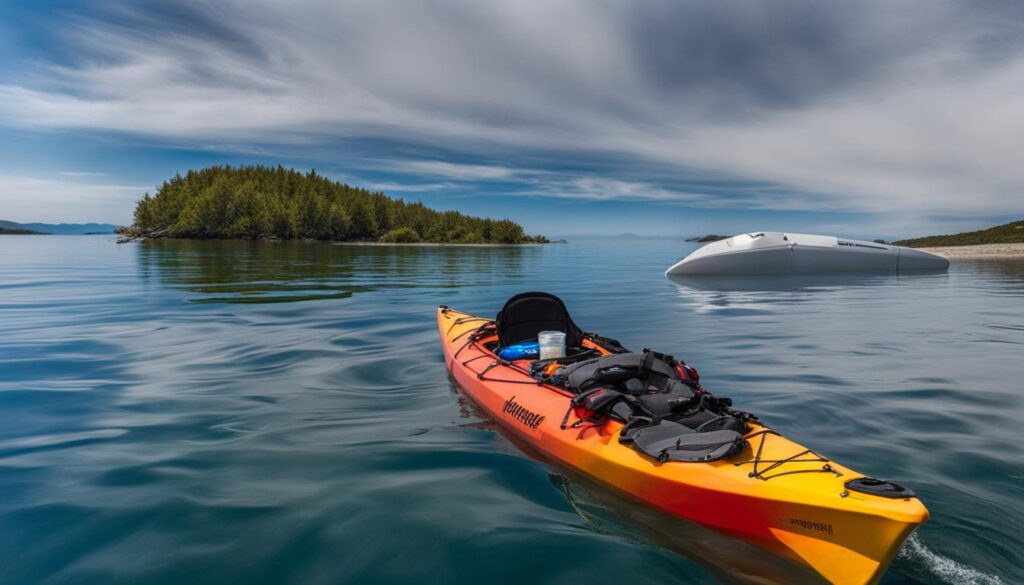
Quote:
“Having the right gear on a kayak camping trip is not just about convenience, it’s about safety. Being prepared for emergencies can make all the difference in a challenging situation.” – Experienced kayaker
Safety Tips for Kayak Emergency Preparedness
In order to ensure a safe and enjoyable kayak camping trip, it’s crucial to follow safety tips for kayak emergency preparedness. By taking the necessary precautions and being prepared for potential emergencies, you can minimize risks and have peace of mind while out on the water.
First Aid for Kayak Campers
Packing a well-stocked first aid kit is essential for any outdoor adventure, including kayak camping trips. Make sure your first aid kit contains basic supplies such as bandages, adhesive tape, antiseptic wipes, and pain relievers. Additionally, consider including items specific to water-related injuries, such as water-resistant bandages and ointments to treat cuts and abrasions caused by paddling or capsizing.
Emergency Communication While Kayaking
Establishing a reliable communication plan is vital for kayak emergency preparedness. Before setting out on your trip, make sure to inform someone on land about your itinerary and expected return time. Bring a waterproof portable communication device, such as a two-way radio or a waterproof cell phone case, to stay connected in case of emergencies. It’s also a good idea to learn and practice basic hand signals to communicate with your kayak companions while on the water.
Kayak Trip Contingency Planning
Having a contingency plan in place is essential for kayak emergency preparedness. Familiarize yourself with the area you’ll be kayaking in and identify potential emergency exit points or safe landing spots. Research local emergency services and know how to contact them in case of an emergency. Stay informed about the weather and sea conditions by checking forecasts before your trip and continuously monitoring changes throughout the day. Adjust your plans accordingly and be prepared to postpone or alter your trip if conditions become unsafe.

By following these safety tips for kayak emergency preparedness, you can enjoy your kayak camping trip with confidence. Remember to prioritize safety, always be prepared, and make responsible decisions while on the water. With the right knowledge and precautions, you can have a memorable and safe adventure in the great outdoors.
Clothing and Footwear for Kayak Emergency Preparedness
When it comes to kayak emergency preparedness, having the right clothing and footwear is essential. Your clothing should provide protection from the elements while also allowing for ease of movement. Layering is key to regulating your body temperature, so opt for lightweight, moisture-wicking base layers, insulating mid-layers, and a waterproof outer shell. Synthetic or wool materials are ideal as they dry quickly and provide insulation even when wet.
For footwear, choose options that are suitable for both in-water and on-land activities. Water shoes or neoprene booties are great choices as they provide traction on wet surfaces and are quick-drying. If you prefer more ankle support, lightweight hiking boots or sandals with a secure fitting are also suitable. It’s important to avoid wearing heavy boots that can become cumbersome and increase the risk of injury in water.
Additionally, consider bringing survival gear like a multi-purpose tool and duct tape for quick fixes. These items can come in handy in emergency situations and can help you make temporary repairs to your kayak or gear if needed. It’s always better to be overprepared when it comes to emergency situations.
Gear Checklist:
- Moisture-wicking base layers
- Insulating mid-layers
- Waterproof outer shell
- Synthetic or wool materials
- Water shoes or neoprene booties
- Lightweight hiking boots or secure fitting sandals
- Multi-purpose tool
- Duct tape
Remember, investing in high-quality clothing and footwear will not only enhance your comfort while kayak camping but also contribute to your safety in emergency situations.
Food, Water, and Shelter for Kayak Emergency Preparedness
When preparing for emergencies while kayaking, it’s essential to consider your food, water, and shelter needs. These basic necessities are crucial for your survival in case of unexpected situations. Here are some important tips to keep in mind:
1. Food: Pack non-perishable items that are lightweight, easy to prepare, and provide sufficient energy. Consider options like energy bars, dried fruits, nuts, and canned goods. Remember to bring a can opener if needed. Plan your meals ahead and portion them into individual servings to reduce waste and ensure you have enough food for the duration of your trip.
2. Water: Water is essential for hydration and should not be overlooked when preparing for emergencies. Bring enough water for your entire trip, accounting for drinking, cooking, and cleaning. Additionally, consider packing a water filter or purification tablets to source fresh water from natural sources like rivers or lakes. This way, you can conserve your supply and have a backup option.
3. Shelter: Having a reliable shelter plan is crucial in case of inclement weather or unexpected overnight stays. Consider packing a lightweight tent that is easy to set up and provides adequate protection from the elements. Alternatively, you can bring a tarp and some rope to create a lean-to structure. Ensure that your shelter is waterproof and securely anchored to withstand strong winds.
By preparing your food, water, and shelter options in advance, you can be better equipped to handle emergencies and ensure your safety while kayaking. Remember to regularly check your supplies and replenish them as needed. Prioritize your well-being and be proactive in your emergency preparedness to have a successful and enjoyable kayak camping experience.
Conclusion
Kayak emergency preparedness is crucial for ensuring a safe and enjoyable kayak camping trip. By packing the right gear, following safety tips, and being prepared for various emergency scenarios, you can have peace of mind while exploring the waterways.
Always prioritize safety and practice responsible kayaking techniques. Familiarize yourself with kayak camping rescue techniques, such as using a paddle float or signaling for help. Remember, being prepared is key.
Whether it’s encountering rough sea conditions, equipment failure, or unexpected weather changes, knowing how to handle kayak trip emergency scenarios is essential. Stay calm, assess the situation, and take appropriate action. By keeping a cool head and applying your knowledge of rescue techniques, you can navigate through any challenges that may arise.
So, before you embark on your next kayak camping adventure, take the time to prepare. Pack your emergency gear, learn the necessary rescue techniques, and plan ahead for potential emergencies. With the right preparation, you can have a memorable and safe kayak camping experience.
FAQ
What gear should I pack for kayak emergency preparedness?
It is important to pack a personal flotation device (PFD), spare paddle, paddle float, bilge pump or sponge, running light or deck light, repair kit, and emergency signaling devices like flares or a whistle.
What safety tips should I follow for kayak emergency preparedness?
Carry a first aid kit, establish a communication plan with your kayak companions, check the weather and sea conditions, and have a contingency plan in place.
What clothing and footwear should I wear for kayak emergency preparedness?
Layer your clothing, choose synthetic or wool materials, and wear footwear suitable for both in-water and on-land activities. Consider bringing survival gear like a multi-purpose tool and duct tape.
What should I pack for food, water, and shelter in kayak emergency preparedness?
Pack non-perishable food that is easy to prepare and modify, bring enough water for your trip, consider a water filter, and have a waterproof shelter plan in place.
How can I ensure a safe and enjoyable kayak camping trip?
Prioritize safety, practice responsible kayaking techniques, and be prepared for various emergency scenarios. Always have the right gear, follow safety tips, and be prepared for emergencies.

